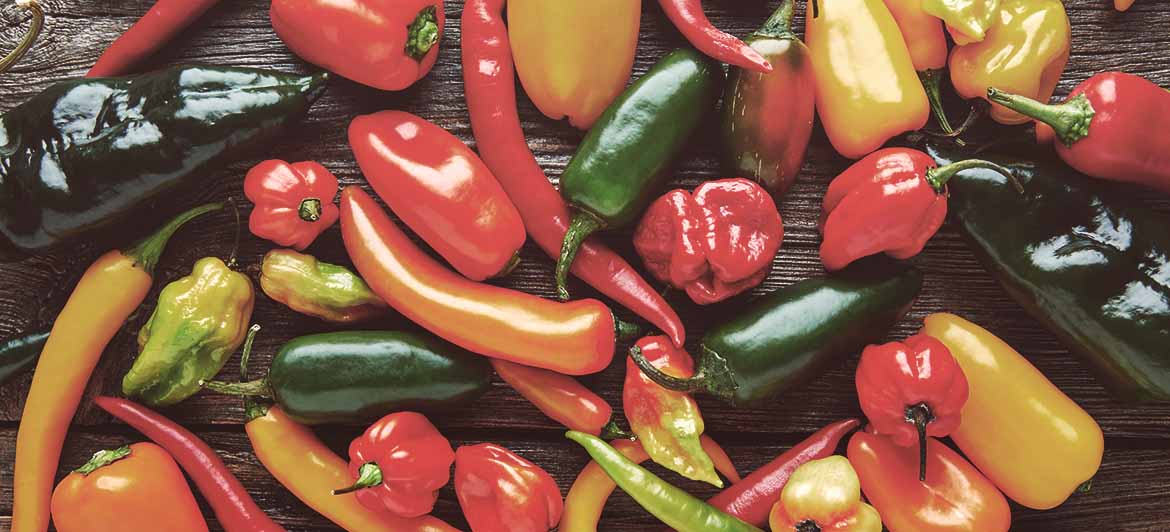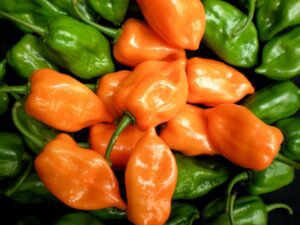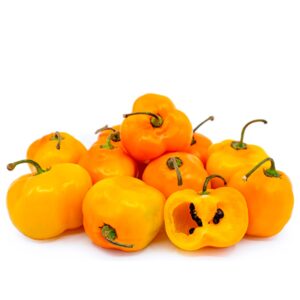Talking about Mexico, means talking about an undeniable gastronomic tradition. Talking about Mexican Food means talking about the wildest, tastiest, and spiciest fruit in the world: The Chile (applause, please)
Chile, from the Náhuatl word “Chili”, is the name us Mexicans use for the berry of the Capsicum plants, one of the most iconic plants of the American Continent.
FROM ANCIENT AMERICA TO THE REST WORLD
Source: https://www.plantasyhongos.es/
Research shows that most of the wild species of chile can be found in South America, due to the great diversity of Capsicum plants that exists in these regions.
All the way from Brazil or maybe Bolivia, chile seeds could have been scattered by birds, attracted by red fruits, these little fellas who are able to eat even the hottest chiles, threw some seeds elsewhere along with the excrement, explaining how the chile would have arrived in Mesoamerica, as a wild plant, thousands of years ago.
Back in 1493 Mr. Columbus desperately seeking for peppercorn or “the black gold” encountered the chile in the Caribbean, along with other traditional ingredients that later became essential in European cuisine.
Spanish and Portuguese traders, obsessed with controlling the spice market, spread the chile around the globe and over the next two hundred years, the chile would revolutionize the gastronomy for the Mediterranean people, passing by China, India, and Indonesia. Nowadays, many places in Africa and India believe that the plants are native to those regions.
IMPORTANCE OF CHILE IN MEXICAN PRE-HISPANIC CULTURES
Chile was essential for the ancient Mexicans, even many traditions persist to this day.
The Aztecs used it not only as an essential part of their daily diet but also had a remarkable diversity of uses for it such as medicinal, commercial, or military use, for instance, the smoke of chiles thrown into the fire was used as war gasses. Even as a radical parenting tool, rumor has it that a little smoke of inhaled chile served to correct a stubborn child.
Mexicas, cultivated chile in chinampas and to honor the God Macuilxóchitl, they practiced a rigorous fast and abstained from eating chile.
Source: https://culturacolectiva.com/
On the other hand, Mayans used to mix chile, honey and cocoa, to obtain “xocolatl” the drink of the gods, nowadays known as hot chocolate.
Moctezuma distributed chile to the town of Tenochtitlán when it was hit by droughts and hunger. And in the cities of Tula and Texcoco, chile was a kind of a currency, there are references that this same use was common in colonial times.
WHERE DOES THE SPICINESS COME FROM?
That spiciness we all love and crave comes from an acidic compound called Capsaicin that is only found in hot chiles. Capsaicin itself is tasteless and odorless and is produced by the glands in the chile placenta, found at the top portion of the chile, below the stem and not in the seeds like it’s commonly believed. The placenta is about sixteen times hotter than the rest of the fruit and is usually removed.
Capsaicin is soluble in milk and alcohol, a sip of cold milk, or a cold alcoholic beverage, can soothe the burning feeling from capsaicin. Or just keep eating chile until you get spicy superpowers like us Mexicans.
Source: https://www.pepperscale.com/
Capsaicin in chiles is measured on the Scoville Scale and expressed in terms of Scoville Heat Units. Bell peppers are the only member of the capsicum family that don’t contain capsaicin and register zero Scoville units.
TOP 3 MOST SPICY CHILES IN MEXICO
1. HABANERO
The most spicy chile produced in Mexico is the Habanero, which grows mainly in Yucatan, Baja California Sur, Chiapas, Tabasco and Veracruz. The most common colors are orange, semi-mature and red when ripe. Freshness and even sweetness with slight acid and citrus touches, deliciously spicy.
Source: https://www.gob.mx/
2. CHILTEPÍN
Almost as spicy, we have Chile Chiltepín, also known as Chipilín or Piquín, found in Sonora and Sinaloa. This one stands out because it has not been domesticated, it cannot be grown in a greenhouse, it is produced only naturally, which makes it one of the most expensive, costing up to 120.00 pesos per kilo.
Source: https://www.mejororganico.com/
3. MANZANO
Chile Manzano, It is very fleshy and juicy, in addition to being recognized by its black seeds and its shiny green, yellow or red skin. In terms of intensity of spiciness, it is one of the hottest chiles in the country, competing with chile .habanero.
Source: https://anyhow.mx/
OTHER VARIETIES OF CHILES USED IN MEXICAN CUISINE
The real flavor is in the kitchen, in the thousands of recipes that our ancient cooks created with great devotion to traditional ingredients, mainly corn but also chile.
Either raw, dried, in ground powder to season, in different sauces for each variety of tacos, in Enchiladas, as Aztec Soup, the traditional Mole, any Mexican stew, or just anything really.
Chile is as versatile as you can imagine, from its size to its shape and color.
Its cultivation is widespread throughout many countries. However, Mexico, thanks to its climatic and geographical variety, offers more than 65 varieties of fresh chiles. If we add dried and smoked chiles, the figure rises to almost 150.
The most consumed chile by Mexicans is Chipotle, a smoke-dried ripe Jalapeño. 60% of the national production is used in the pickle Jalapeño industry, 20% is eaten fresh and the rest is destined to the elaboration of chipotles.
Another popular chile in Mexican cuisine, all the way from Puebla, is the Poblano, used to make one of the most typical dishes of the region: stuffed chile with nogada sauce and pomegranate. When dried, this chili takes the name of Chile Ancho or Mulatto.
Chile Guajillo is highly prized in the kitchen, but not many know its fresh version, which is called Mirasol. It goes from a green tone to an intense and bright red. However, when it dries, a favorite for marinades and sauces for its color, aroma, and flavor.
Widely used in Oaxaca, Jalisco and Nayarit, another essential chile for Moles, Chile Chilaca or Chile Pasilla, the dry version, rich, smokey, earthy flavor.
Chile de bola, small and round. When it dries, it’s called Chile Cascabel or Rattle Chile, because the loose seeds tend to rattle inside when shaken.
Native to north Puebla and Hidalgo, Chile Serrano, cultivated in mountain areas. Either green or red, it is considered spicy, with a smooth and shiny shell. When dried is known as Chile de Árbol or Chile Seco and it’s one of the favorite for Salsa Asada.
Source: https://dam.cocinafacil.com.mx/
The National Institute of Anthropology and History (INAH) states that chile is present in 90% of Mexican dishes, including some of our traditional beverages and sweets!
TOP 3 MOST SPICY CHILES FROM AROUND THE WORLD
- The Carolina Reaper is officially the World’s Hottest chile, with an average SHU of 1,641,000 up to 2.2 million SHU. 200x hotter than a Jalapeño. With a unique stinger tail that is unlike any other chile and every pod is different. This chile doesn’t just have heat, but also a fruity flavor.
- The Trinidad Scorpion Moruga Blend, with a 2,009,231 SHU. Native to the lands of Moruga in Trinidad and Tobago. Great flavour with a non-stop-increasing heat.
- The 7 Pot Douglah, the hottest pepper you can find that isn’t red with a 1,853,936 SHU. Challenging the odds by being brown and scortching hot.
SPICE UP YOUR HEALTH
Although chiles’s most notorious and appreciated aspects have to do with its use as a condiment, and the fact that it makes your mouth burn might make eating it sound as something you shouldn’t do, Chile has nutritional and medicinal values, as Fray Bernardino de Sahagún and the Spanish doctor Francisco Hernández had pointed out.
The main substance in chile, the one that causes the spicy sensation, not only is it unique, but it’s oddly beneficial for the body.
Source: https://laopinion.com/
HEALTHY CHILE FACTS
– It is assumed that it can help prevent clots and hardening of the arteries, reducing the possibility of heart attacks.
-Rich in vitamins A, B, C. This spicy fruit has such a high content of vitamin C that its nutritional value is higher than some citrus fruits.
-High content of Potassium, Magnesium, and Iron among other substances
-The pleasure/itchy reaction that it produces when consuming them has psychological benefits, releasing endorphins as well as sex and some drugs, experiencing a sense of euphoria when eating spicy foods.
-Currently, some products for muscle pain are made with chili extract that takes advantage of the anti-inflammatory qualities of capsaicin.
– Antioxidant that hinders the reaction of free radicals that cause aging.
-According to recent research it may be useful for destroying cancer cells.
Contrary to what is believed, the intake of chili does not produce ulcers or damage to the stomach, on the contrary, it promotes good digestion because it increases the production of saliva and gastric juices. What could cause these damages, are the vinegar, salt or other substances with which certain hot sauces are made.
Source: https://cdn.kiwilimon.com/
Surely you are now craving for something spicy.
Let the Eating with Carmen Food Tour Guides, spice up your next visit to the Mayan Riviera.
-Abbey, chiquita pero picosa.















